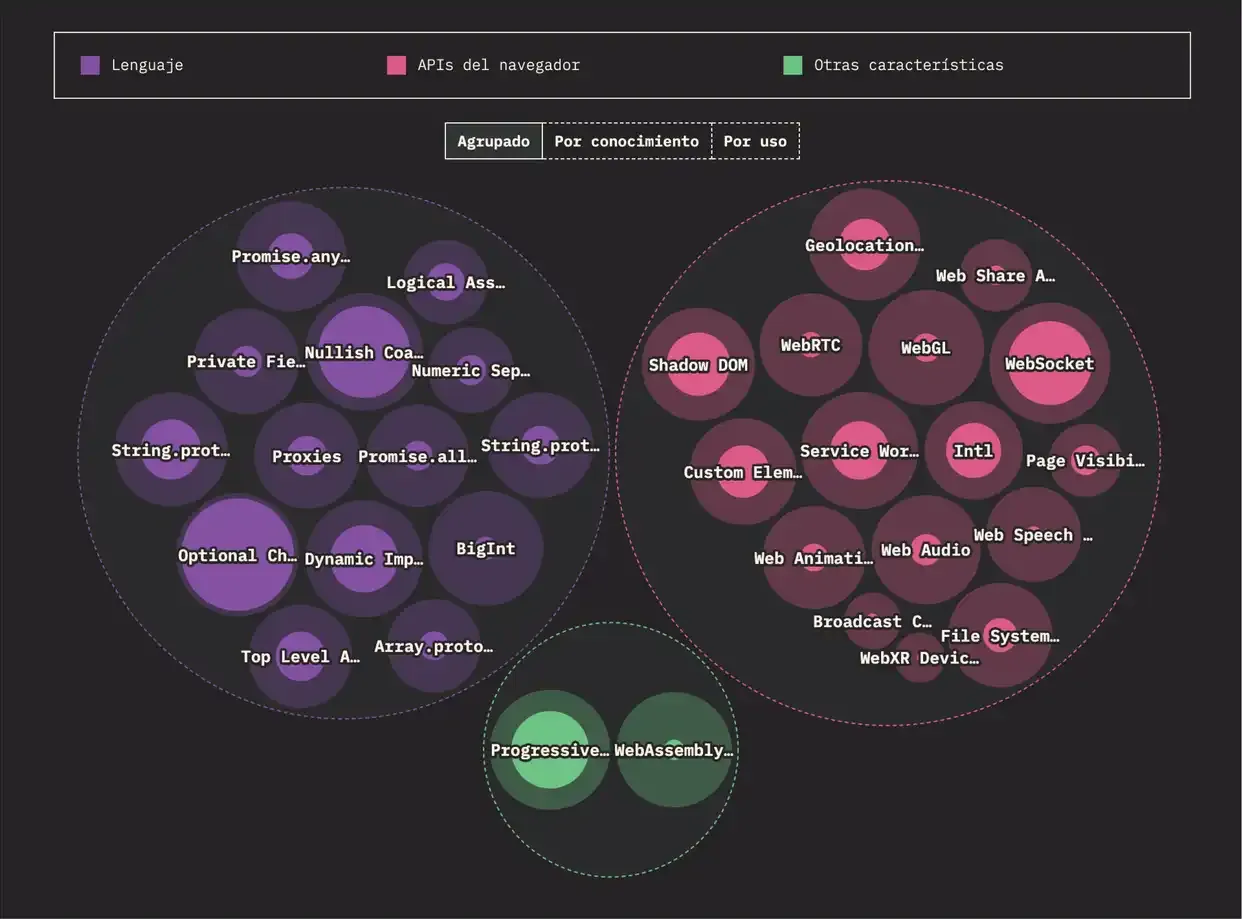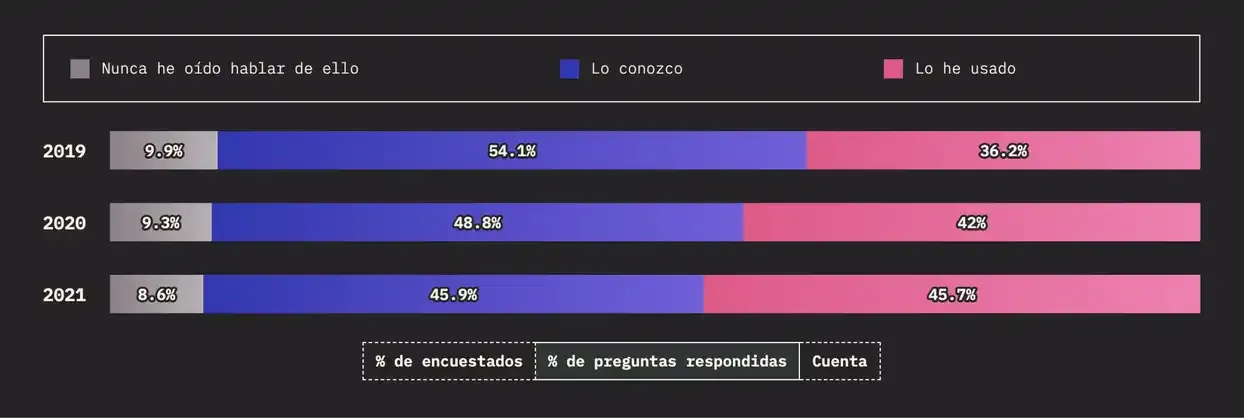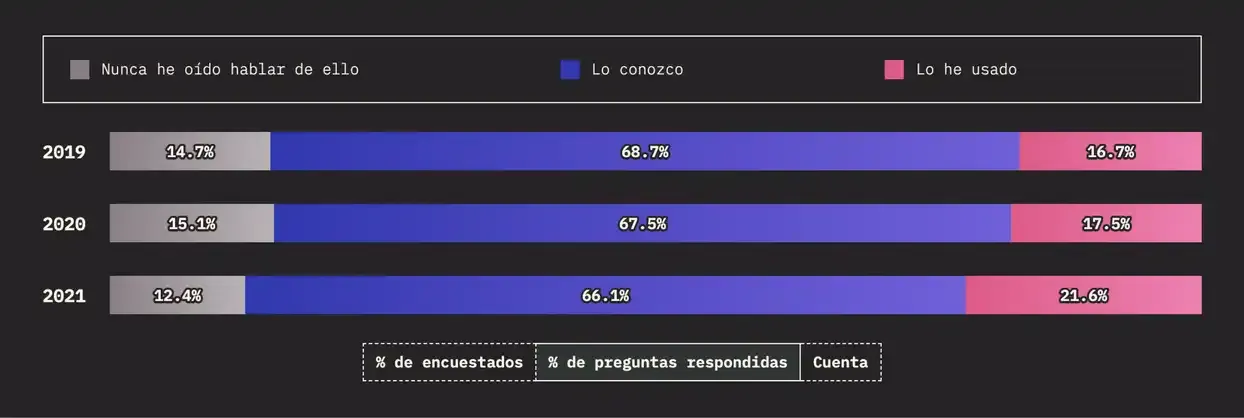The results of the latest State of JavaScript 2021 survey are now available. After the postponement of last year's edition, the survey was resumed at the beginning of this year. With a sample of 16,085 respondents worldwide, this report aims to identify trends in the web development ecosystem in order to anticipate and facilitate developers' technology decision-making. It is an annual consultation conducted by Sacha Greif with the help of a team of open source contributors and consultants.
The speed at which the JavaScript world is moving is astounding. That's why it's important for developers to keep up to date with everything that's moving in this area. Although being up to date on new technologies and tools that emerge around JS is important, betting on a stack that allows us to specialize is essential to build increasingly robust and advanced digital tools. There, between know-how and experimentation, is where we find the perfect balance.
After analyzing the results of the latest survey on the state of JavaScript, at Workoholics we have made a small “self-assessment” exercise. So, in this post we are going to try to explain our vision, experience and level of adoption of a programming language that is present in 97% of websites.
Level of use of the different JavaScript features
As an agency specialized in the development of digital products, we must keep abreast of the entire ecosystem that emerges around this programming language. The State of JavaScript report is of great help to us in this regard, as it provides us with information regarding the use of different languages, APIs, or other relevant and emerging features in the field of JS.
In the following image, it is observed that many of the JS features have a high level of knowledge on the part of the developers. However, it can be seen that many of them have a low level of use by the developer community, probably because they are relatively new features.

At Workoholics, every project offers us a new opportunity to incorporate JavaScript-based tools. However, it is not always easy to implement new languages, usually due to the project's own structural or circumstantial reasons. However, within our possibilities, we try to devote time and effort to keep ourselves updated thanks to JavaScript standards aimed at ensuring the interoperability of web pages in different web browsers, as is the case of ECMAScript.
This dedication allows us to spot opportunities to implement new features as they are added to JavaScript. However, it is not always easy to have the time to keep up with absolutely everything that comes along. That's why surveys like the State of JavaScript are very useful for us to understand where this language is moving, spot emerging trends and focus our learning.
JavaScript and its application in the agency's projects.
At Workoholics, the use of JS is transversal to most of the projects we carry out, regardless of whether they are based on Angular, React or any other library. In our commitment to the first and, to land it in a specific case of the agency, we believe it is important to highlight the advantages offered by using JavaScript when developing mobile apps.
Due to the requirements of some of the agency's projects, the use of Ionic and Capacitor allows us to provide specific interface elements for each platform through a library of native components for iOS and Android, which allows us to distribute applications for each operating system from the same source code, thus avoiding having to create two apps in different programming languages, causing an increase in efficiency and significant savings in time and resources.
Service workers, one of the reasons to choose Angular

Among the features provided by the browser through its APIs, we find service workers, that is, scripts that browsers execute in the background and open the door to functions that do not require a web page or user interaction. This feature is one of the advantages of working with Angular, since it is implemented “out of the box”. In addition, it serves us to improve the performance and reliability of the webapps we develop, being one of the necessary elements to convert an application into a progressive web application (PWA). At Workoholics, as in the industry, we are aware of the growing trend of PWAs and we use them more and more in our projects.
But why did we choose to specialize in Angular? Although it is true that we have had the opportunity to use the React library maintained by Facebook/Meta and the Open Source community in various agency projects, it is Google's option that has the highest level of adoption at Workoholics. The reason? Mainly because of the know-how accumulated after years of experience working with this framework developed in TypeScript. In addition, its robustness and the large amount of functionalities not dependent on third-party libraries that it incorporates, makes it exponentially increase our efficiency when developing projects based on Angular, despite the fact that its learning curve is higher. Finally, it is worth mentioning the large community around this technology, (also in our immediate environment, with the recent creation of the "Basque Angular" initiative).
WebGL: JS technology for the web in motion

Another of the browser APIs that has been attracting our attention in recent times is WebGL. As can be extracted from the survey, although it is a feature with a high degree of awareness among the people surveyed, its level of use is quite low. Created by the Mozilla Foundation, WebGL is a standard specification that defines an API implemented in JS oriented to render 3D graphics within any browser. Thus, taking into account the importance that interactivity and motion have gained within UX/UI design, in our agency we are investing time in experimenting with it.
Gatsby, all about performance optimization
Although we said that in Workoholics we mainly choose to specialize in Angular, this does not imply at all that we leave React aside. In fact, the website where you are reading this article uses Gatsby, which is nothing more than a static site generator built with ReactJS and powered by GraphQL.
Okay, but what are the advantages of choosing Gatsby over other options? It's clear to us: loading speed. When we build a static website using Gatsby, we benefit from optimal performance. A fast loading speed is beneficial both for the UX and for search engines such as Google, which increasingly give more importance to the loading speed of websites when it comes to ranking them in their search engine. In addition, performance also has an impact on business, and can cause a 7% reduction in conversions in those websites that load more slowly.
And so much for this small exercise of reflection based on the results of the latest survey on the state of JavaScript in the world. We will continue to report.
